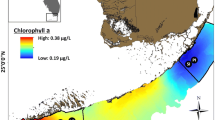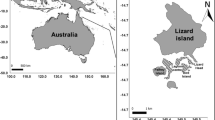Summary
On many Caribbean fringing coral reefs, two closely related and ecologically similar damselfishes, the beaugregory (Stegastes leucostictus Müller and Troschel) and the cocoa damselfish (S. variabilis Castelnau), occupy nonoverlapping vertical distributions. In St. Croix (USVI), beaugregory are very abundant in shallow water back reef habitats (1–2 m depth) while cocoa damselfish are restricted to the base of the forereef (10–15 m depth).
In this study, the roles of habitat selection at settlement and juvenile persistence were investigated to determine their influence on this pattern of zonation. Settlement events observed at intervals over a two-year period revealed that habitat selection occurred at settlement and was confined to habitats occupied by adults. In addition, differences in juvenile persistence (due to mortality and/or emigration) were found when species were translocated between depths. Over a period of 100-days, juvenile beaugregory moved from 1 m to 12 m depth suffered four-fold greater losses at the deeper sites than shallow water controls, while translocated cocoa damselfish suffered twice as many losses in shallow water than controls at 12 m depth. Despite these differences in persistence, growth rates of the two species were similar and independent of depth. These results indicate that preferential habitat selection at settlement, perhaps an evolutionary response to differential juvenile mortality, may play a deciding role in determining distributions of ecologically similar species of coral reef fishes.
Similar content being viewed by others
References
Adey WH (1975) The algal ridges and coral reefs of St. Croix, their structure and development. Atoll Res Bull 187:1–67
Aldenhoven JM (1986) Local variation in mortality rates and lifeexpectancy estimates of the coral-reef fish,Centropyge bicolor (Pisces: Pomacanthidae) Mar Biol 92:237–244
Anderson GRV, Ehrlich AH, Ehrlich PR, Roughgarden JD, Russell BC, Talbot FH (1981) The community structure of coral reef fishes. Am Nat 117:476–495
Böhlke JE, Chaplin CCG (1968) Fishes of the Bahamas and adjacent tropical waters. Livingston Publishing Company, Wynnwood, Pennsylvania, USA
Bushek D (1988) Settlement as a major determinant of intertidal oyster and barnacle distributions along a horizontal gradient. J Exp Mar Biol 122:1–18
Butman CA (1987) Larval settlement of soft-sediment invertebrates: the spatial scales of pattern explained by active habitat selection and the emerging role of hydrodynamical processes. Oceanogr Mar Biol Annu Rev 25:113–165
Carr MH (1991) Habitat selection and recruitment of an assemblage of temperate zone reef fishes. J Exp Mar Biol Ecol 146:113–137
Choat JR, Bellwood DR (1985) Interactions amongst herbivorous fishes on a coral reef: influence of spatial variation. Mar Biol 89:221–234
Cohen J (1969) Statistical power analysis for the behavioral sciences. Academic Press, New York, New York
Connell JH (1961) Effects of competition, predation byThais lapillus and other factors on natural populations of the barnacleBalanus balanoides Ecol Monogr 31:61–104
Connell JH (1985) The consequences of variation in intertidal settlements vs. post-settlement mortality in rocky intertidal communities. J Exp Mar Biol Ecol 93:11–45
Crisp DJ (1974) Factors influencing settlement of marine invertebrate larvae. In: Grant P, Mackie AM (eds) Chemoreception in marine organisms. Academic Press, New York, New York, pp 177–265
Davis AR (1987) Variation in the recruitment of the subtidal colonial ascidianPodoclavella cylindrica (Quoy & Gaimard): the role of substratum choice and early survival. J Exp Mar Biol Ecol 106:57–71
Doherty PJ (1982) Some effects of density on the juveniles of two species of tropical territorial damselfishes. J Exp Biol Mar Biol 65:249–261
Doherty PJ (1983) Tropical territorial damselfishes: is density limited by aggression or recruitment? Ecology 64:176–190
Doherty PJ, Williams McB (1988) The replenishment of coral reef fish populations Oceanogr Mar Biol Annu Rev 26:487–551
Emery AR (1973) Comparative ecology and functional osteology of fourteen species of damselfish (Pisces: Pomacentridae) at Alligator Reef, Florida Keys. Bull Mar Sci 23:649–770
Forrester GE (1990) Factors influencing the juvenile demography of a coral reef fish. Ecology 71: 1666–1681
Fowler AJ (1989) Description, interpretation and use of the microstructure of otoliths from juvenile butterflyfishes (family: Chaetodontidae). Mar Biol 102:167–181
Gaines S, Roughgarden J (1985) Larval settlement rate: a leading determinant of structure of an ecological community of the marine intertidal zone. Proc Natl Acad Sci USA 82:3707–3711
Gronell A (1980) Space utilization by the cocoa damselfish,Eupomacentrus variabilis (Pisces: Pomacentridae). Bull Mar Sci 30:237–251
Grosberg RK (1981) Competitive ability influences habitat choice in marine invertebrates. Nature 290:700–702
Grosberg RK (1982) Intertidal zonation of barnacles: the influence of planktonic zonation of larvae on vertical distribution of adults. Ecology 63:894–899
Hadfield MG, Scheuer D (1985) Evidence for a soluble metamorphic inducer inPhestilla: ecological, chemical and biological data. Bull Mar Sci 37:556–566
Highsmith RC (1982) Induced settlement and metamorphosis of sand dollar (Dendraster excentricus) larvae in predator free sites: adult sand dollar beds. Ecology 63:329–337
Hurlbert SH (1984) Pseudoreplication and the design of ecological field experiments. Ecol Monogr 54: 187–211
Hurlburt CJ (1991) Larval substratum selection and post-settlement morality as determinants of the distribution of two bryozoans. J Exp Mar Biol Ecol 147:103–119
Itzkowitz M (1985) Aspects of the population dynamics and reproductive success in the permanently territorial Beaugregory damselfish. Mar Behav Physiol 185:57–69
Jensen RA, Morse DE (1984) Intra-specific facilitation of larval recruitment: gregarious settlement of the polychaete,Phragmatopoma californica (Fewkes). J Exp Mar Biol Ecol 83:107–126
Jokiel PL (1990) Transport of reef corals into the Great barrier Reef. Nature 347: 665–667
Jones GP (1987a) Competitive interactions among adults and juveniles in a coral reef fish. Ecology 68: 1534–1547
Jones GP (1987b) Some interactions between resident and recruits in two coral reef fishes. J Exp Mar Biol Ecol 56: 145–160
Jones GP (1988) Experimental evaluation of the effect of habitatstructure and competitive interactions on the juveniles of two coral reef fishes. J Exp Mar Biol Ecol 123:115–126
Kaufmann KW (1981) Fitting and using growth curves. Oecologia 49:293–299
Keough MJ, Downes BJ (1982) Recruitment of marine invertebrates: the role of active larval choices and early mortality. Oecologia 54:348–352
Keough MJ (1984) Dynamics of the epifauna of the bivalvePinna bicolor: interactions among recruitment, predation and competition. Ecology 65:677–688
McFarland WN, Brothers EB, Ogden JC, Shulman M, Bermingham EL, Kotchian-Prentiss NM (1985) Recruitment patterns in young French grunts,Haemulon flavolineatum (family Haemulidae), at St. Croix, Virgin Islands. Fish Bull US 83:151–161
Meadows PS, Campbell JI (1972) Habitat selection by marine invertebrates. Adv Mar Biol 10:271–382
Morse ANC, Morse DE (1984) Recruitment and metamorphosis ofHaliotis larvae induced by molecules uniquely available at the surfaces of crustose red algae. J Exp Mar Biol Ecol 75:191–215
Morse DE, Hooker N, Duncan H, Jensen L (1979) Gamma-amino butyric acid, a neurotransmitter, induces planktonic abalone to settle and begin metamorphosis. Science 204:407–410
Ogden JC (1972) An ecological study of Tague Bay reef St. Croix, U.S. Virgin Islands. Spec Publ Mar Biol, No. 1, West Indies Laboratory, Fairleigh Dickinson University, Christiansted, St. Croix, United States Virgin Islands, U.S.A.
Osman RW, Whitlatch RB, Zajac RN (1989) Effects of resident species on recruitment into a community: larval settlement versus post-settlement mortality in the oysterCrassostrea virginica. Mar Ecol Prog Ser 54:61–73
Olson RR, McPherson R (1987) Potential vs. realized larval dispersal: fish predation on larvae of the ascidian,Lissoclinum patella. J Exp Mar Biol Ecol 110:245–256
Pitcher CR (1988) Validation of a technique for reconstructing daily patterns in the recruitment of coral reef damselfish. Coral Reefs 7:105–116
Raimondi PT (1988) Settlement cues and determination of the vertical limit of an intertidal barnacle. Ecology 69:400–407
Raimondi PT (1990) Patterns, mechanisms, consequences of variability in settlement and recruitment of an intertidal barnacle. Ecol Monogr 60:283–309
Raimondi RT (1991) Settlement behavior ofChthamalus anisopoma larvae largely determines the adult distribution. Oecologia 85:349–360
Randall JE (1963) An analysis of the fish population of artificial and natural reefs in the Virgin Islands. Caribb J Sci 2:31–47
Russ G (1984) Distribution and abundance of herbivorous grazing fishes in the Great Barrier Reef. I. Levels of variability across the entire continental shelf. Mar Ecol Prog Ser 20:23–34
Robertson DR (1988) Abundances of surgeonfishes on patch-reefs in Caribbean Panamá due to settlement, or post-settlement events? Mar Biol 97:495–501
Robertson DR, Foster SA (1982) Off-reef emigration of young adults of the labrid fishEpibulus insidiator. Copeia 1982:227–229
Sale PF, Douglas WA, Doherty PJ (1984) Choice of microhabitats by coral reef fishes at settlement. Coral Reefs 3:91–99
Schmitt P (1984) Marking growth increments in otoliths of larval and juvenile fish by immersion in tetracycline to examine the rate of increment formation. Fish Bull US 82:237–242
Shulman MJ, Ogden JC, Ebersole JP, McFarland WN, Miller SL, Wolf NG (1983) Priority effects in recruitment of coral reefs. Ecology 64:1508–1513
Stoner DS (1990) Recruitment of a tropical colonial ascidian: relative importance of pre-settlement vs. post-settlement processes. Ecology 71:1682–1690
Sokal RR, Rohlf FJ (1981) Biometry. WH Freeman and Co., New York
Sweatman HPA (1983) Influence of conspecifics on choice of settlement sites by larvae of two pomacentrid fishes (Dascyllus aruanus andD. reticulatus) on coral reefs. Mar Biol 75:225–229
Sweatman HPA (1985) The influence of some species of coral reef fishes on larval recruitment. Ecol Monogr 55: 469–485
Sweatman HPA (1988) Field evidence that settling coral reef fish larvae detect resident fishes using dissolved chemical cues. J Exp Mar Biol Ecol 124:163–174
Thresher RE, Colin PL, Bell LJ (1989) Planktonic larval duration and population structure of western and central Pacific damselfishes (Pomacentridae). Copeia 1989:420–434
Underwood Al, Denley EJ (1984) Paradigms, explanations, and generalizations in models for the structure of intertidal on rocky shores. In: Strong DR, Simberloff DS, Abele LG, Thistle AB (eds) Ecological communities: conceptual issues and evidence. Princeton University Press, Princeton New Jersey, pp 151–180
Underwood AJ, Fairweather PG (1989) Supply-side ecology and benthic marine assemblages. Trends Ecol Evol 4:16–20
Victor BC (1982) Daily growth increments and recruitment in two coral reef wrasses,Thalassoma bifasciatum andHalichoeres bivittatus. Mar Biol 71:203–208
Victor BC (1983) Recruitment and population dynamics of a coral reef fish population. Science 219:419–420
Victor BC (1986) Larval settlement and juvenile mortality in a recruitment-limited coral reef fish population. Ecol Monogr 56:145–160
Waldner RE, Robertson DR (1980) Patterns of habitat partitioning by eight species of territorial Caribbean damselfishes (Pisces: Pomacentridae). Bull Mar Sci 30:171–186
Wellington GM, Victor BC (1989) Planktonic larval duration of one hundred species of Pacific and Atlantic damselfishes (Pomacentridae). Mar Biol 101:557–567
Wellington GM, Victor BC (1992) Regional differences in duration of the planktonic larval stage of reef fishes in the eastern Pacific ocean. Mar Biol (in press)
Wilkinson L (1990) SYSTAT: the system for statistics. SYSTAT, Inc., Evanston, Illinois, USA
William DMcB (1981) Dynamics of the pomacentrid community on small patch reefs in One Tree Lagoon (Great Barrier Reef). Bull Mar Sci 30:159–170
Williams DMcB, Hatcher AI (1983) Structure of fish communities on outer slopes of inshore, mid-shelf and outer shelf reefs of the Great Barrier Reef. Mar Ecol Prog Ser 10:239–250
Williams DMcB, Russ GR, Doherty PJ (1986) Reef fish-large scale distribution and recruitment. Oceanus 29:76–82
Young CM, Chia FS (1981) Laboratory evidence for delay of larval settlement in response to a dominant competitor. Int J Invertebrate Reprod (Amsterdam) 3:221–226
Author information
Authors and Affiliations
Rights and permissions
About this article
Cite this article
Wellington, G.M. Habitat selection and juvenile persistence control the distribution of two closely related Caribbean damselfishes. Oecologia 90, 500–508 (1992). https://doi.org/10.1007/BF01875443
Received:
Accepted:
Issue Date:
DOI: https://doi.org/10.1007/BF01875443




